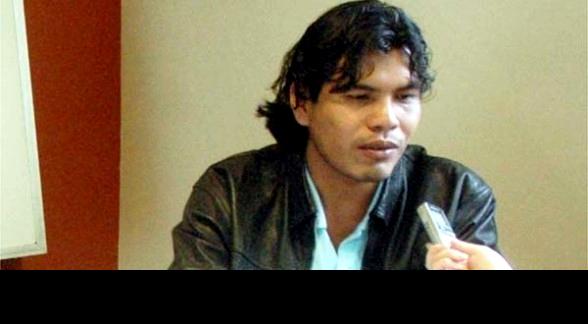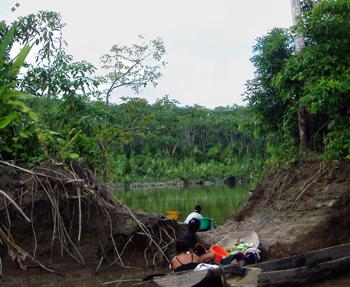An Interview with Adolfo Moye
This interview was originally made in late 2010. I have translated it into English and added an introduction to give some background on the subject.
To read the article in the original Spanish :
http://www.isiborosecure.com/tipnisdocuinvasion.htm
Who is Adolfo Moye?
Adolfo Moye is the leader of the community representatives for the TIPNIS area. He is the leader of the Subcentral TIPNIS, which represents the 64 indigenous communities of the area and collectively is the legal owner of the indigenous territory.
Where and what is TIPNIS?
TIPNIS is the “Isiboro-Secure Indigenous Territory and National Park”. It is located in the departments of Beni and Cochabamba, in Bolivia. It is doubly protected because it is a national park and also an indigenous territory of the moxeños, yurakarés and chimanes.
It has an area of 1,000,000 hectares and is an area of exceptional biodiversity and natural beauty.
Isiboro Secure National Park was created on 22 November 1965. In September 24, 1990, the park was declared the ancestral homeland of the Mojeño, Yuracaré and Chiman peoples by Supreme Decree.
TIPNIS always been the scene of conflicts and confrontations between Indians and the settler communities, who dispute the ownership of the land.
The economy and livelihood of the indigenous communities of TIPNIS are based on the exploitation of natural resources: hunting, fishing, food gathering, agriculture and livestock supplemented with the sale of handicrafts. Agriculture is the most important activity for the settlers.
The colonists practice is slash and burn agriculture to the point of the exhaustion of the land, followed by migration to another space. This is compounded by the constantly growing settler population. The soil depletion and population growth has led to the invasion and change of use of forests to agricultural land, largely devoted to coca production.
Changing land use from forest into agricultural land has restricted hunting areas, fishing and food gathering, particularly for those living in the settled area.
In this area, families have little access to basic natural resources because of the extreme reduction of wildlife, pollution of rivers, and reduction of agricultural soils. This has helped to marginalize the indigenous population, who often end up working for the colonists and being exploited by them.
Map showing the spread of deforestation and settlement in TIPNIS : http://www.isiborosecure.com/tipnismapadefo.htm
In 1990, the then-leader of the Subcentral TIPNIS, Marcial Fabricano and Evo Morales agreed to draw a red line in order to prevent any further colonization of the territory.
In 1994 was the first agreement which set an area of 92 hectares in which settled colonists and indigenous communities would live. In October 1996, Law 1715 was passed, which stated that : “The settlements and the occupation of communal lands after the enactment of this law are illegal, so the authors of these acts shall be punished by eviction, involving force if necessary, at the request of the competent judicial or administrative authority. ”
Despite this legal framework, between 1991 and 2009 the “red line” that limits the area of colonization south of TIPNIS has changed seven times. Rather than limiting colonization, it would be safer to say that the red line merely describes it.
Settlers continued to enter and spread their coca crops in the next decade. In July 2006, President Evo Morales spoke for the first time in the conflict and sent a police contingent to San Miguelito to evict invaders. Nevertheless, in 2007 the settled area of TIPNIS reached 101 000 hectares, inhabited by 14 indigenous and 67 coca growers’ unions.
In mid-June 2009, the Morales government finally gave executive legal title to the territory of TIPNIS. But the encroachments continued. In September 2009 the colonist Laureano Rodriguez was killed in a clash with Indians near the Yuracarés town of San Miguelito. In September 2009, members of the Joint Task Force and the Police eradicated coca crops and burned nearly a hundred shacks in squatter camps.
In August 2010, the Morales government approved the environmental license for the Villa Tunari-San Ignacio de Moxos road, thus opening up a huge new frontier to the penetration of settlers, coca, oil companies, loggers and drug traffickers.
The project for the construction of the road has been divided into 3 sections. The first and third sections have been approved. The second section is the crucial one that would pass through the heart of TIPNIS. It has not yet been granted permission.
The cruel invasion of TIPNIS under the government of Evo Morales
Adolfo Moye said that when he was 10 years old, he and his classmates had to lie down in front of a machine trying to desecrate the TIPNIS national park. “Now that we are older with more reason we must preserve the land for our children and future generations,” said Moye, alarmed by the spread of coca cultivation and the intensification of colonization and enslavement since 2007.
He claims that, “We support the government unconditionally, but we see that the peasant base of the President from Oruro, Potosí and Cochabamba are expanding the growing of coca, which is damaging our country and our community.”
“The current government is trampling on us in the most cruel way, far more than in previous years, and violates the rights of indigenous peoples as if they have no value, even though they are recognized by the new Constitution and the law”.
Q. What are the consequences of coca-colonization in the TIPNIS?
A. We have seen many communities end up surrounded by colonists, like for example in Santisima Trinity community, where I live along with 140 indigenous families mixed with some colonists. We are in the centre of the colonized zone and are surrounded by coca growers.
In the community of Limo, our brothers of the moxeño and Yuracaré peoples now have just one hectare and work as employees of the colonists. Their children have had to migrate to the regional capitals to search for work and are seeking to adopt another way of life.
In many villages only the elderly remain. Some communities, like Puerto Patiño and Isiborito have become extinct and we do not know where our brothers and sisters who lived there have gone.
Q. What has changed the lifestyle of the Indians?
A. We are running out of space and ability to live in peace, the expansion of coca and deforestation are the biggest threats. Our main source of income was the cultivation of rice, banana and cassava, but some Indians influenced by the settlers have chosen to plant coca on the grounds that it can bring in more money.
We are not accustomed to divide up land individually. By tradition we have a communal land title for present and future generations of indigenous people, but on August 7 the new secretary general of the Federation of Cochabamba told us that we have to change to their system.
For some settlers and indigenous residents the only source of life is coca and they believe that the Trinidad – Villa Tunari road will bring development. That is their ideology.
Q. Who benefits from the Trinidad – Villa Tunari road?
A. The road passes through the indigenous populations of Holy Trinity, San Jose and San Antonio de Moleto; the other communities are far away. The road is designed to benefit only the settlers of Villa Tunari, Chpiriri, Eteregazama and other towns in the settlement area known as the polygon 7.
Q. Has the government consulted and met with you?
A. We have never had these consultations. Perhaps at some point they spoke with someone in the TIPNIS who did not legally represent the Indians, but in terms of a consultation with popular participation, there has not even been an invitation from the authorities. I regret that the Deputy Minister of Environment, who is aligned with the ABC has approved the environmental license for the road without being informed of what TIPNIS represents, and without consulting the indigenous residents.
The government has violated several laws, such as Article 6 of Decree 22610, which states that all construction and development work, particularly roadside channels and pipelines, which take place in the Isiboro-Secure National Park and Indian Territory, must have a detailed environmental impact study approved by the executive authorities with the participation of the indigenous organization in the region. According to this decree, the works in progress should be halted until the environmental impact study, which must consult and be coordinated with the indigenous organization in the region.
Q. What impact will the construction of the road have?
A. I think in the next 10 years many communities will disappear. I worry about the small, vulnerable populations of no more than 60 families of chiman or moxeño people who are not accustomed to living with people alien to their culture. With the planned road that would go right through the area we would be removing their ability to live a peaceful and healthy life. They would be forced to migrate elsewhere.
Many chimane people from San Borja came to TIPNIS because a road was constructed through that area and they do not like it. With this road they will take away the last place left for the chimanes and the worst of it is that now they will have to find their own luck.
Q. Have you ever been threatened for criticizing and opposing the road?
A. We have suffered threats of all kinds, including strong threats. It is difficult to lead a “rebel” indigenous movement in nothing less than the birthplace of Evo Morales’ political career, specifically in the New Aroma union.
Recently, the settlers warned the brothers of the Holy Trinity community that if they do not accept the road they will be denied development or government and they will have to face the consequences. After we took a firm stand not to allow the progress of the road settlers blocked and banned the local shops from selling us staples.
MAS lawmaker Julio Salazar came to tell the community members that if they refused to grow coca they would be stripped of their land, meaning that the only way to protect their land would be to plant it with coca, otherwise the state might strip us of it through military intervention. I am very sorry that the leaders close to our President are creating problems. They make fine speeches, but their actions are a different thing.
P. What are the natives of TIPNIS asking from the government?
R. We believe that solutions can be found, the construction of the road is secondary to us, the most important thing is to ensure our community rights as indigenous peoples and respect from the government and all sectors of society, including settlers and farmers. It is not right that the government seek to develop regardless of the environment, animals and even the lives of indigenous people.
Brother Evo should not forget that TIPNIS has symbolic importance, as it represents one of the first steps towards the historic Constituent Assembly and Constitution, which first recognized the rights and livelihoods of indigenous and native peoples.
TIPNIS was also the first “autonomous indigenous territory” held by the Chiman Mojeño-Trinitarian Yuracaré people and under Articles 289, 290, 291, 292, 293, 294, 296 and Article 385 of the new Constitution supported by departmental and national indigenous organizations and senior government officials who were present at the ceremony which was held on February 9 this year.
For more articles about the TIPNIS, in English and Spanish:
http://www.isiborosecure.com/index.html
With thanks for the above information to – https://network23.org/cochabambino/2011/05/19/an-interview-with-adolfo-moye/





make a click to save the protected area of the PARK TIPNIS in Bolivia:
http://www.avaaz.org/es/save_tipnis/
the problem is that the government is making a road that will go across the TIPNIS park and many animals and
trees will be killed… help us!!
thanks for saving earth.